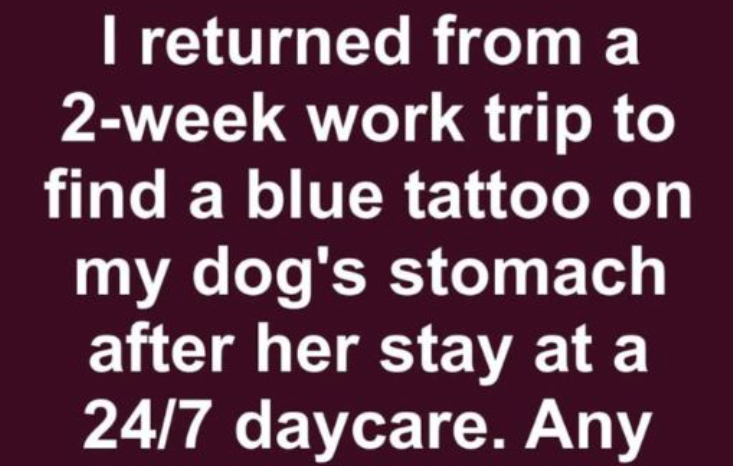Returning from a two-week work trip, I spotted an unusual blue tattoo on my dog Zuni’s stomach, which materialized during her stay at a 24/7 daycare facility. I posted about it in a local pet owners’ Facebook group, seeking information before contacting the facility directly.
I shared the post with a photograph of Zuni, my pit-lab mix, resting on her side, revealing a small, faint blue marking near her belly. The mark resembled a simple line shape—perhaps a number or a letter—and it definitively was not present when I dropped her off at the daycare.
I spent a substantial amount of time examining the mark closely before taking the picture.
The Luxury Daycare and The Evasive Staff
I had been away at a professional training conference in Vancouver, enduring two weeks of extensive meetings, late evening meals, and travel fatigue. I missed Zuni terribly and had selected a “luxury” 24/7 dog daycare called WagMore Acres, which advertised surveillance cameras, frequent updates, and joyful Instagram posts of happy canines.
The check-in process proceeded without incident, and the staff seemed genuinely welcoming. When I picked Zuni up, she appeared fine—perhaps slightly tired, but her tail was wagging, and she leaned affectionately against me before sleeping soundly throughout the car ride home. It wasn’t until that evening, while giving her a belly rub, that I discovered the blue mark.
Within an hour of my Facebook post, responses began to pour in.
Group members hypothesized it might be a spay tattoo, a common indicator that a dog has been sterilized, preventing redundant surgeries. Others mentioned that animal shelters frequently employ such tattoos. This seemed a reasonable possibility, except Zuni was already spayed when I adopted her two years prior.
And I was absolutely certain she possessed no tattoo back then.
That night, I sent an email to WagMore Acres and followed up with a telephone call the subsequent morning. A staff member named Carly answered, initially sounding cheerful, but her tone became distinctly guarded when I mentioned the tattoo.
She paused.
Then she stated, “Oh, allow me to check with our shift manager. May I return your call?”
I agreed to her request.
An hour elapsed. Then three.
By midday, I called again, but no one picked up the phone.
A feeling of deep unease began to take hold.
The Confrontation
I decided to visit the daycare facility in person. It was a brief fifteen-minute drive from my residence, situated behind a strip mall containing a yoga studio and a vape shop. The building looked precisely as I remembered it—bright murals of cartoon dogs, artificial turf, and a sign proclaiming, “WagMore: Where Dogs Are Family!”
At the front reception desk, a new employee did not recognize me.
When I inquired about Carly, she informed me that Carly no longer worked there.
“She departed last week,” the employee said, glancing nervously toward the back room. “It happened quite suddenly.”
I requested to speak with the owner or manager. Following a slight hesitation, the employee vanished into the rear of the building.
I waited for almost ten minutes.
A tall, pale man holding a clipboard emerged, introduced himself as Jeff, and offered a strained smile.
I explained Zuni’s situation, showed him the photograph, and stressed that she was already spayed before her stay. He leaned in, studied the image, and stated matter-of-factly, “That is a spay tattoo. It is standard practice. Some veterinarians add them at a later time.”
“But she was already spayed,” I reiterated.
He shrugged his shoulders. “It could have been a precautionary measure. We collaborate with local vet clinics if there is any uncertainty.”
“Uncertainty about what?” I demanded. “You were not authorized to perform any medical procedures without my explicit permission.”
His entire demeanor shifted. He became defensive, speaking vaguely about “standard protocols” and “misunderstandings.” He referenced a general waiver I had signed, which included a provision about necessary veterinary procedures.
I demanded the name of the clinic they partnered with. He claimed he would need to “check the system” and promised to email me the details.
I departed without offering a response.
No email ever arrived.
The Veterinarian’s Revelation and the Altered Microchip
That night, sleep completely escaped me. Questions swirled—what else had transpired with Zuni? She appeared healthy, but what if the daycare was intentionally concealing something?
The next morning, I took Zuni to our trusted veterinarian, Dr. Nguyen, who had been caring for her since I adopted her. I showed him the tattoo, and he frowned before gently lifting Zuni onto the exam table.
He studied the mark very closely.
“This is recent,” he confirmed. “And executed poorly.”
I asked if it represented a spay tattoo.
“It is designed to look like one,” he replied carefully. “But it is not located in the usual position, and the ink is uneven. It looks like an amateur attempt.”
My heart sank with dread.
He inspected Zuni’s spay scar, confirming it was unchanged and that no new surgical procedure had taken place.
“So they tattooed her,” I concluded. “To make it appear as if she had been spayed?”
“Or possibly to conceal something else,” he suggested.
I felt suddenly nauseated.
Dr. Nguyen proposed bloodwork to eliminate other potential health concerns. I consented immediately.
The results were predominantly normal, but one detail was highly alarming.
Zuni’s microchip data had been changed.
The chip still functioned, but it now listed a new owner: Rachel Nevin.
I stared intently at the name on the printout, hoping it represented an error.
I had never encountered Rachel Nevin.
Dr. Nguyen accessed Zuni’s original microchip records, registered precisely under my name and address. He explained that someone must have submitted forged documents to the chip registry in order to change the ownership details.
The individual pieces of the puzzle began to fit together.
The tattoo. The altered microchip. Carly’s abrupt departure. Jeff’s evasive answers.
Someone at WagMore had attempted to claim Zuni as their property.
The Investigation Unfolds
I contacted the microchip company immediately. After verifying my identity as the original owner, they froze the chip and flagged the change for fraud. I asked precisely how the information had been altered.
The representative explained, “Someone emailed scanned forms—a photo ID, vet records, the standard requirements.”
I requested copies of the submitted documents.
They agreed, but only upon receiving legal authorization.
I reached out to my friend Junie, who works at a law firm. Although not an expert in pet law, she drafted a formal request on my behalf.
Three days later, I received a ZIP folder containing the documents.
Opening them sent a distinct chill through me.
The photo ID was blurred but bore the name Rachel Nevin, with an address in nearby Riverside. The vet records were extensively fabricated, although some pages seemed to be scanned from Zuni’s actual file, suggesting someone at WagMore had specific access to her records.
On one form, I noticed Carly’s signature clearly visible in the corner.
She had not quit—she was either dismissed or left after attempting to steal my dog.
I updated the Facebook group with this alarming information. Within an hour, a woman named Luisa sent me a direct message. She immediately recognized the name Rachel Nevin—her friend’s dog had completely vanished after a stay at WagMore two months earlier.
I asked for all the specific details. Luisa called me promptly.
Her voice trembled as she spoke.
“My friend Marta had a golden retriever named Miso. She left him at WagMore before visiting family in Mexico. When she came back, they claimed he escaped during an outdoor break—they said he slipped his collar. But Marta always meticulously checked his harness, and he was microchipped.”
“What was the outcome?” I asked.
“They provided her with a refund and sent a sympathy card. But she never located Miso. No shelter or vet ever had any record of him.”
I asked if Miso had a spay or neuter tattoo.
Luisa confirmed it was blue, located on his belly.
Resolution and Perspective
I could not sleep a moment that night.
Fueled by coffee and absolute determination, I began exhaustive research. I scoured property records, Yelp reviews, and LinkedIn profiles. Carly had been WagMore’s “intake coordinator” and had previously volunteered at an animal shelter that subsequently closed due to the mismanagement of animals.
I also discovered that WagMore was not owned by Jeff but by an LLC connected to a man named Marcus Liddell. Further investigation revealed troubling civil suits—lost dogs, sloppy record-keeping, and one case settled privately for an undisclosed financial sum.
The following day, I reported everything to animal control.
They took my complaint extremely seriously, particularly the microchip tampering, and formally opened an investigation.
More pet owners came forward over the next two weeks, sharing stories of strange pet behavior, inexplicable injuries, and permanently missing dogs. One owner had records showing her dog was neutered twice, according to conflicting documentation.
Within a month, WagMore was completely shut down.
A local news outlet covered the story extensively, calling it “A Betrayal of Trust at a Beloved Daycare.” It was dramatic reporting but entirely accurate.
Carly faced no formal criminal charges due to insufficient evidence, but the investigation confirmed she had been re-homing dogs to various friends or contacts, falsely claiming they were strays or abandoned pets. Marcus, the owner, was fined for negligence and permanently barred from operating pet-related businesses within the state.
Jeff, meanwhile, completely disappeared—likely already moving on to his next venture.
Then, two months later, I received a handwritten letter from Riverside.
It was from Rachel Nevin, the name listed as Zuni’s false owner.
She wrote:
“I had no idea Zuni was stolen. Carly informed me she was surrendered by a family unable to keep her, and she provided adoption papers. I only had Zuni for four days before the microchip company flagged it as fraudulent. I am deeply sorry for what happened.”
She included her phone number, offering to speak.
Initially, I had zero interest in connecting.
But a week later, my deep curiosity prevailed.
I called Rachel. She was soft-spoken and genuinely remorseful. She had recently lost her own dog to cancer and was incredibly eager to adopt a new companion. Carly had specifically described Zuni as a dog who desperately needed a calm home after being shuffled between multiple owners.
“She was the sweetest dog I have ever encountered,” Rachel said, her voice clearly breaking. “But I know she rightfully belongs to you.”
I paused briefly.
Then I asked, “Was she well cared for with you?”
Rachel gave a small, gentle laugh. “More than well cared for. She slept constantly on my feet and followed me everywhere I went.”
That night, I hugged Zuni a little tighter than usual.
At first, I felt completely consumed by anger and betrayal, wary of trusting absolutely anyone. But now, nearly a year later, watching Zuni nap comfortably on the couch, I feel a significant sense of perspective.
Perhaps Zuni’s experience ultimately helped uncover a much larger issue.
And perhaps, for four days, she brought genuine comfort to someone who was deeply grieving.
Cherish your pets. Remain extremely vigilant. Always follow your instincts.
Even the most seemingly welcoming places may not always guarantee safety.




